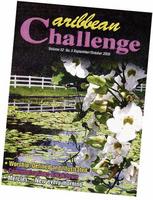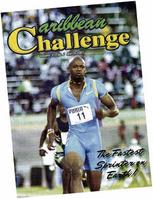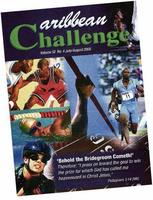

Ardent readers of the magazine Caribbean Challenge have been grappling with the news contained in its latest edition, that this evangelical publication, barring a miracle, is going out of business.
The writings have long been on the wall for this 52-year-old staple of the Caribbean Christian community. It has been struggling for many years to stay afloat. But its publishers, Christian Literature Crusade (CLC), believe that it cannot continue to make the magazine available within the prevailing economic climate.
CLC is an international interdenominational ministry that spans 57 countries. It seeks primarily to sell and promote books, booklets, magazines and tracts as a means to influence persons to become born-again Christians. Its ministry is also to spur Christians towards greater levels of maturity.
The magazine was begun by the late F. George DaCosta, founding director of CLC in Jamaica. DaCosta's vision was that the magazine would be simple enough for ordinary Jamaicans to read and that the content would present its reader with the challenge of making a decision to become a born-again Christian.
The magazine's primary audience has, for years, been the English-speaking Caribbean, with Jamaica being its biggest market. At its peak in the 1960s, the Caribbean Challenge had a circulation of 30,000 across the region. At present, the regional circulation is under 10,000, with about 5,000 copies being sold in Jamaica.
In Jamaica, CLC is headed by Eaton Facey, who, for the last eight years, has been the de facto editor of Caribbean Challenge.
Lack of financial resources


Facey explained that the decision was taken to shut down the magazine "against the background of a history of an inability on our part to pull certain key factors together to make it grow; principal among them is the financial resources and human resources. We have had a history of difficulty of collection from the distributors. We have also had a difficulty with getting the right type of personnel to keep the magazine in high demand in terms of the nature of the articles and in terms of the presentation of the publication.
"We are conscious that the magazine has really made an impact over the years. It is an institution. We actually waited as long as we could - even to the point of probably being forced to have to close it. It is a painful decision. Sentiments also got involved. But when you look at the overall focus of the ministry, a decision had to be taken to maintain the ministry (of CLC) and to sort of sharpen our focus.
"The focus of CLC is to serve the Church and the population outside of Christ through literature. The actual publishing of the Challenge is accommodated, but it does not get in the way of the main focus. Our international representatives have expressed to us their concerns that it (the Challenge) is taking up too much of our time and energies.
"The decision to shut down the magazine was taken last March. We did, kind of, sense that the need would eventually arise. We had asked a consultant to give us a finding and a recommendation as to what we could probably do and as to whether there was still a market for it. Out of the findings of the consultant, we made a decision that we would not have been able to do what he was recommending," Facey said.
That consultant was the Reverend Dr Billy Hall, Bible teacher and a former lecturer in journalism at the Caribbean Institute of Media and Communication. Hall recommended that the magazine be re-engineered to target the youth market. He also recommended that the publication should increase its pages from the typical 20 to 60 and that professional editors and writers and business managers be employed to manage the publication.
According to Hall, "The Challenge must seek to become a cultural tutor and reporter and reflector concerning the region, from religious, political and social perspectives. Nevertheless, the evangelical perspective must be visible and vocal in the publication. The assumption no longer carries that the masses are there just waiting to be served with a gospel message presented more or less like a leaflet or tract. The Challenge certainly could be described when originally conceived and launched as an extended tract, even 'glorified gospel tract'. Then, such a publication could be defended, but today would be lacking in mass appeal."
Early editors

The Caribbean Challenge had among its early editors, Marion Manning of CLC in Barbados. She was followed by Jamaicans Las Sibble, John Keane and Facey. Though these persons had strong administrative skills, none had professional journalistic experience. Facey, for example, explained "I have no formal training in the area. So that limits what I can do. Basically, the magazine is put together by two of us, myself and Ruth Desborough (a veteran CLC staff worker)."
The imminent demise of the Challenge, is widely viewed as symptomatic of some of the financial hurdles facing the Christian literature ministry in Jamaica and elsewhere. In Jamaica, the Back to the Bible Bookstore, has had to scale down its operations. Also, Source of Light Mission Bookstore, is poised to scale down some of its operations to better meet the financial challenges it faces.
Some within the CLC Caribbean family believe that the demise of the Caribbean Challenge is also a reflection of the extent to which churches have become more inward looking and therefore less poised to support parachurch organisations. Furthermore, it is arguable that the content of the publication was for the most part unable to compete with other Christian publications that have emerged within the region.
Hall told Mind & Spirit that when the Challenge was born, "the fledging evangelical movement in the region lacked a strong common identity. Soon, the magazine became the most popular of its kind and, under the editorship of Marion Manning of Barbados, peaked in the 1960s with a circulation of 30,000.
Dwindling circulation
"Today, with the circulation under 10,000, and with a 40-year-old printing press, and the evangelical movement more sophisticated and divided, the magazine faces a dinosaur death for its narrow focus on verdict evangelism without social evangelism and a literary standard that did not rise with the level of education more widespread today. The publication breathes its last breath this month.
Unless rescued by another organisation with a vision to counteract the negative realities mentioned, the magazine will have ended its time for particular service" said Hall.
He continued, "Internationally, the demise of the magazine would be consistent with a trend, even in media-rich United States. Already the once highly reputable Moody Monthly has perished. By April next year, the famous Christian Science Monitor will be available only online. Circulation has fallen from a peak 220,000 in the 1970s to a mere 2,000 today."
Supplement
Facey said "The thinking of CLC from the outset was to have a subsidised magazine, which could almost be given away, which would serve the purpose of being a kind of supplement for the enrichment of the lives of the saints, and a challenge to those outside of Christ for salvation. We stayed too long to try and maintain that vision. It was a noble vision, but it was too costly after a while."
There is yet a glimmer of hope for the continuance of the magazine. Facey disclosed that CLC is in talks with two groups of investors, who are considering taking over the publication."There are two interested parties talking to us about taking over the Challenge, but nothing is concrete just yet. There is the possibility that someone may take it up and run with it. It may not be the same in terms of its content, and presentation, but we will be working to maintain the name."
Meantime, CLC is making back issues of the publication available. "We do have quite a library of back issues. We are also putting together all the issues from the inception. We are going to bind them. And maybe, if persons are interested, we can reproduce them.
"We are contemplating using various storage technologies. There is talk of a souvenir edition next year - as a keep sake. What would be included in that is yet to be decided. It was thought it should be historic. It was also thought that it should include a 'Where are they now' feature. This would include some people for which stories were done about in the past, to get an update on where are they now."
Facey said some regular readers of the Challenge have been downhearted with the news of its imminent cessation. Some have even cried, he said. For some, the Challenge was also a useful teaching tool, especially for Sunday school classes.
According to Facey, "We have had persons, who have said, 'what can we do?' But when it was outlined what it is that is involved, many of them did not realise how involved it was financially and in terms of personal resources. But yes, we have had persons who have said, 'We can't afford to let the magazine die'."
Send feedback to mark.dawes@gleanerjm.com.